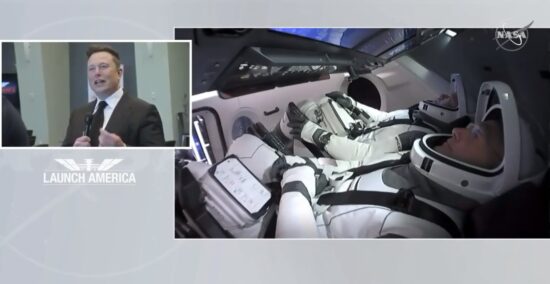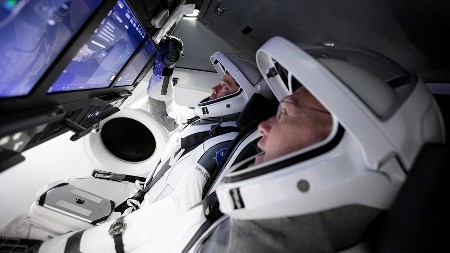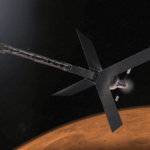Editor’s note: Bad weather caused the mission to the International Space Station to be scrubbed. The next window for an attempt will be on Saturday, May 30th. Other than that what follows requires no amendments.
May 27, 2020 – The singular vision of a serial entrepreneur is now driving the U.S. space program despite what you may think. NASA and even the U.S. military are deferring to SpaceX, the company Elon Musk founded in 2002. Musk has always believed that the key to our species’ survival is multiplanetary, that is, we need to find homes elsewhere in the Solar System and beyond. Why? Because Musk doesn’t want us to go the way of the dinosaurs who experienced a devastating natural event approximately 65 million years ago when an asteroid wiped out terrestrial and marine dinosaurs, leaving only birds as their descendants.
Musk’s company began modestly with a series of test flights of his Falcon rocket model designated number 1. Most of the early flights failed but in 2008 the Falcon 1 placed a payload into low-Earth orbit. The following year the company successfully launched a payload from a paying customer. SpaceX then leaped past the interim numbers to build a much bigger rocket, the Falcon 9, which will today launch two astronauts to the International Space Station (ISS) aboard a SpaceX-designed capsule that is a far cry from anything NASA ever built. Falcon 9 has been going aloft since 2010 and SpaceX has achieved with it partial reusability since 2015.
The space capsule which SpaceX calls Dragon was first conceived for shipping cargo to the ISS. Version 1.0 was pretty conventional-looking. But Version 2.0 is a leap in development. The first Dragon flew in 2010 and in 2012 made it to the ISS. Even the Dragon was being designed for reusability. Reusability has been the mantra of SpaceX from inception. The idea was to reduce the cost of getting to space and back. NASA, a government agency, had tried partial reusability with the Space Shuttle program but high costs and two loss-of-spacecraft failures ended that program.
SpaceX’s approach to reusability was far simpler and safer than that conceived by NASA. SpaceX placed a barge down-range from its first Falcon 9 reusable flights which saved on fuel and made it possible to adjust the landing target to the rocket’s trajectory whether taking off from California or Florida. It was a simple solution. Later on, with more sophisticated software and extra fuel capacity, Falcon 9 first-stages could turn around and return to base for landings which meant no transportation issues and less downtime between flights.
And now SpaceX is one of three companies chosen for NASA’s Artemis Program, a return of human missions to the Moon with plans to stay. SpaceX’s candidate lunar lander is its Starship, part of a mega-rocket that will be totally reusable and capable of interplanetary travel once all the kinks get resolved. Where NASA sees the Moon as the current goal with Mars a distant 2030s objective, SpaceX sees this next mission objective as a practice run to interplanetary flight later in the decade, a good ten years ahead of the Agency’s timelines.
SpaceX hasn’t made these great leaps forward on its own. The company has enjoyed a relationship with NASA that has cross-fertilized it with technology and experience to advance its program. This afternoon, when Dragon 2.0 carries two astronauts to the ISS, the expertise of NASA will have been passed along to the young SpaceX upstart and the latter may never look back.
The next year should see further clarification in the relationship between the Agency and SpaceX. Will the Space Launch System find itself confined to the dustbin within the next few years as the Starship and other commercial space companies advance technologies and reduce costs to turn humanity into a spacefaring species? And when our species makes its first footfall on Mars will they be riding on a NASA-conceived system, or one devised and built by SpaceX? I am betting on the latter and wondering what this ultimately will mean for the Agency’s role beyond this decade.

















